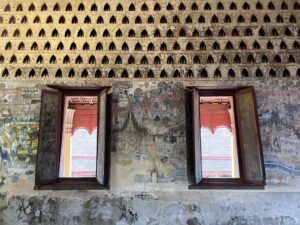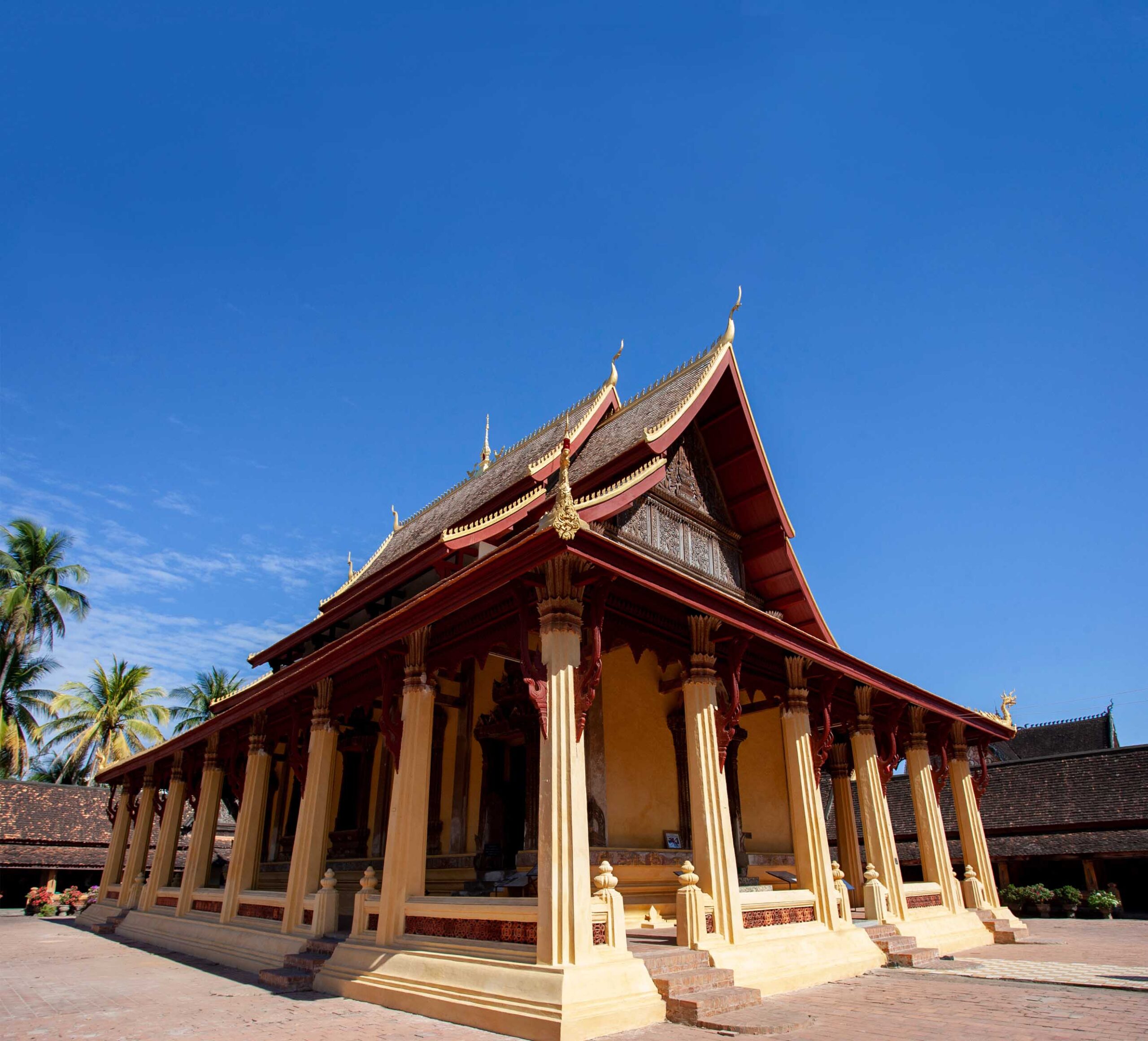ວັດແຫ່ງເມືອງເອກຂອງອານາຈັກລາວລ້ານຊ້າງ
ເປັນອີກຄັ້ງໜຶ່ງທີ່ຂ້າພະເຈົ້າມີໂອກາດໄດ້ມາຢ້ຽມຊົມປູຊະນິຍະສະຖານທີ່ມີຄວາມໝາຍທາງວັດທະນະທຳ ແລະ ປະຫວັດສາດອີກແຫ່ງໜຶ່ງຂອງອະດີດອະນາຈັກລາວລ້ານຊ້າງ ນັ້ນກໍຄື ສະຕະສະຫັສສາຣາມ (ແປວ່າ ວັດແສນ) ທີ່ປວງຊົນລາວທັງຫລາຍຮູ້ຈັກໃນນາມ “ວັດສີສະເກດ”ແຫ່ງນີ້, ທີ່ບໍ່ວ່າຈະເຂົ້າມາໃນເຂດວັດແຫ່ງນີ້ຈັກເທື່ອກໍຍັງຄົງຄວາມງົດງາມທາງດ້ານວັດທະນະທຳ ແລະ ປະຫວັດສາດໄວ້ຄືກັບວ່າສາມາດຢຸດເວລາໄວ້ເພື່ອໃຫ້ພວກເຮົາໄດ້ສຳພັດກັບກິ່ນອາຍຂອງຄວາມເປັນອະນາຈັກລາວລ້ານຊ້າງທີ່ຈະເລີນຮຸ່ງເຮືອງໃນເມື່ອກ່ອນ ຄືກັນກັບວ່າພວກເຮົາເຄີຍເປັນໜຶ່ງໃນປະຊາຊົນທີ່ເຄີຍໃຊ້ຊີວິດຢູ່ໃນຫ້ວງເວລານັ້ນຕັ້ງແຕ່ກ້າວທຳອິດທີ່ໄດ້ກ້າວຂາຍ່າງເຂົ້າມາໃນເຂດວັດແຫ່ງນີ້. ວັດສີສະເກດແຫ່ງນີ້ສ້າງຂຶ້ນ ເມື່ອປີ ຄສ 1818 ພາຍໃຕ້ການປົກຄອງຂອງເຈົ້າອານຸວົງທີ່ເປັນກະສັດ ແລະ ພະອົງໄດ້ນຳພາໄພ່ຟ້າລາດສະດອນເຕົ້າໂຮມຄວາມສາມັກຄີສ້າງບ້ານແປງເມືອງຄືນໃໝ່ ພ້ອມທັງໄດ້ປະຕິສັງຂອນປູຊະນິຍະສະຖານຄືນໃໝ່ເຊັ່ນ: ພະທາດຫລວງ, ຫໍພຣະແກ້ວ ແລະ ໄດ້ສ້າງວັດສີສະເກດທີ່ມີຄວາມສຳຄັນທາງດ້ານປະຫວັດສາດ, ວິວັດທະນາການຂອງປະຊາຊົນລາວທາງດ້ານວັດທະນະທຳ, ອຸດົມຄະຕິ, ຄວາມອາດສາມາດໃນອະດີດທີ່ຜ່ານມາ.

ໃນຂະນະທີ່ກຳລັງຈະຍ່າງເຂົ້າໄປໃນບໍລິເວນລານວັດ ຂ້າພະເຈົ້າກໍໄດ້ສະດຸດຕາເຂົ້າກັບ “ສີລາຈາລຶກ” ທີ່ແຂວນຢູ່ເທິງຝາທາງເຂົ້າດ້ານຂວາມືຂອງປະຕູວັດ, ໂດຍສີລາຈາລຶກແຜ່ນນີ້ເປັນແຜ່ນຫີນທີ່ສ້າງຈາກຫີນສີນ້ຳຕານເນື້ອລະອຽດ ແລະ ກ້ຽງງາມດີ ພ້ອມກັບລວດລາຍແກະສະລັກດ້ວຍມືໃນການບັນຍາຍເຖິງປະຫວັດການກໍສ້າງ, ການຈັດວາງ ແລະ ການສົມໂພດສະເຫຼີມສະຫຼອງວັດສີສະເກດນັ້ນ. ຫຼັງຈາກຊືື່ນຊົມຄວາມປານີດຂອງສີລາຈາລຶກນັ້ນແລ້ວ ຂ້າພະເຈົ້າກໍໄດ້ຕົກຕະລຶງໃນຄວາມງົດງາມຂອງສິມທີ່ຕັ້ງເດັ່ນຢູ່ກາງວັດແຫ່ງນີ້ຕັ້ງແຕ່ຍັງບໍ່ທັນໄດ້ຍ່າງກ້າວເຂົ້າໄປຂ້າງໃນສິມ ເພາະແນມຈາກທາງນອກນີ້ກໍສາມາດເຫັນພຣະພຸດທະຮູບອົງໃຫຍ່ທີ່ຊົງສະຖິດຢູ່ພາຍໃນພ້ອມກັບແສງໄຟສີເຫຼືອງທີ່ສາດສ່ອງພາດຜ່ານຍິ່ງເຮັດໃຫ້ຄວາມງົດງາມຂອງພາບນັ້ນຕິດຢູ່ໃນຄວາມຊົງຈຳແບບທີ່ບໍ່ສາມາດຈະລືມໄດ້ຈົນປັດຈຸບັນນີ້, ຍັງບໍ່ໝົດພຽງເທົ່ານັ້ນ ເມື່ອເວົ້າເຖິງຄວາມສຳຄັນຂອງສິມວັດສີສະເກດນັ້ນກໍແມ່ນສະຖານທີ່ສຳຄັນ ແລະ ສັກສິດ ພ້ອມທັງເປັນບ່ອນປະດິດສະຖານພຣະພຸດທະຮູບປະທານ (ອົງແສນ) ແລະ ພຣະພຸດທະຮູບປາງຕ່າງໆ, ລວມທັງວັດຖຸສຳຄັນທີ່ຮັບໃຊ້ພິທີກຳທາງສາສະໜາຕ່າງໆ ແລ້ວຍັງເປັນບ່ອນປະຕິບັດສາສະນາກິດຂອງພຣະພິກຂຸສົງ, ສະຖານທີ່ສູດປະຕິໂມກ ແລະ ໃຊ້ໃນພິທີບວດ. ນອກຈາກນັ້ນ ໃນເມື່ອກ່ອນກໍຍັງໃຊ້ເປັນສະຖານທີ່ຈັດພິທີດື່ມນໍ້າສັດຈະ ໃນການປົກຄອງບ້ານເມືອງໃນສະໄໝກ່ອນອີກດ້ວຍ. ເມື່ອໄດ້ເຂົ້າມາໃນສິມແລ້ວກໍຈະພົບກັບຮູບແຕ້ມເທິງຝາທີ່ບັນຍາຍເຖິງເຫດການຕ່າງໆຂອງນິທານພື້ນເມືອງຊາດົກເລື່ອງ ພະລະສັງຂະຫຍາ ເຊິ່ງຕົວລະຄອນເອກແມ່ນເຈົ້າຊາຍໂບກຂະລະພັດ, ໂດຍການແຕ້ມແຕ່ງນີ້ເປັນສີມືຊ່າງຂອງນັກຈິດຕະກຳສິນລາວເຮົາໃນສະໄໝນັ້ນທີ່ໄດ້ພັນລະນາເຖິງທີ່ຕັ້ງຂອງພະລາດຊະວັງ, ຫໍ, ໂຮງ, ພຸດທະປະຫວັດຂອງພຣະພຸດທະເຈົ້າ, ການດຳລົງຊີວິດຂອງໄພ່ຟ້າລາດສະດອນ ແລະ ພາບທຳມະຊາດທີ່ເຮັດໃຫ້ຂ້າພະເຈົ້າໄດ້ໃຊ້ຄວາມຄິດໃນຫ້ວງຈິນຕະນາການຂອງຕົນເອງຈົນມາຮູ້ສຶກໂຕກໍໃນຕອນທີ່ຕົນນັ້ນຍ່າງມາທາງຝາກຂວາຂອງວັດແລ້ວພົບກັບ “ຮາງຫົດ” ທີ່ເປັນຮາງລິນລັກສະນະຍາວ ແລະ ເຮັດດ້ວຍໄມ້ທ່ອນດຽວພ້ອມກັບລວດລາຍແກະສະລັກເປັນຮູບນາກ ໂດຍຮາງຫົດນີ້ຈະໃຊ້ໃນໂອກາດບຸນປີໃໝ່ລາວ ຫຼື ໃນພິທີບວດຫົດ, ເຊິ່ງຊາວພຸດທັງຫຼາຍກໍຈະຮ່ວມໃຈກັນໃນພິທີສົງນ້ຳພະ ໂດຍຈະມີການນຳເອົານ້ຳອົບນ້ຳຫອມທີ່ມີດອກໄມ້ຕ່າງໆປະສົມຢູ່ນຳນັ້ນຢາດລົງໃສ່ໃນຮາງຫົດເພື່ອໃຫ້ໄຫຼໄປຫົດສົງພຣະພຸດທະຮູບ ຫຼື ພຣະສົງສຳມະເນນອົງທີ່ຖືກອະພິເສກເພື່ອເລື່ອນຂື້ນສູ່ຂັ້ນຖັດໄປ.

ອີກໜຶ່ງຈຸດພິເສດທີ່ບໍ່ສາມາດຈະເບິ່ງຂ້າມໄດ້ຂອງວັດສີສະເກດນັ້ນກໍຄືຝາສິມທັງ 4 ເບື້ອງທີ່ຖືກແກະສະລັກເປັນຊ່ອງກຸດໂດຍລວມທັງໝົດມີ 1,026 ຊ່ອງ ແລະ ແຕ່ລະຊ່ອງກຸດຈະບັນຈຸພຣະພຸດທະຮູບນ້ອຍ ຊ່ອງລະ 2 ອົງ ໂດຍລວມທັງໝົດແລ້ວພຣະພຸດທະຮູບນ້ອຍຈະມີຈຳນວນປະມານ 2,052 ອົງ. ນອກຈາກນັ້ນແລ້ວຍັງມີສາງເກັບພຣະພຸດທະຮູບທີ່ແຕກຫັກໃນສະໄໝສົງຄາມຮຸກຮານລາວແຕ່ ຄ.ສ ປີ 1826-1828 ໂດຍພຣະພຸດທະຮູບທີ່ຢູ່ໃນສາງນີ້ແມ່ນໄດ້ນຳມາຈາກວັດຕ່າງໆທົ່ວນະຄອນຫຼວງວຽງຈັນໃນຊ່ວງນັ້ນ ໂດຍມີຈຳນວນ 996 ອົງ ແລະ ພຣະພຸດທະຮູບເຫຼົ່ານີ້ແມ່ນລ້ວນແຕ່ຫຼໍ່ດ້ວຍທອງສຳລິດທັງໝົດເຊິ່ງສາງນີ້ຈະຕັ້ງຢູ່ທາງຝາກຊ້າຍຂອງສິມວັດສີສະເກດ.
ສຸດທ້າຍນີ້ບໍ່ວ່າທ່ານຈະເປັນນັກທ່ອງທ່ຽວທັງພາຍໃນ ຫຼື ຕ່າງປະເທດກໍ່ຕາມ ຂ້າພະເຈົ້າຢາກໃຫ້ທຸກທ່ານຮູ້ສຶກໄດ້ວ່າ ສະຖານທີ່ທ່ອງທ່ຽວຂອງປະເທດລາວເຮົານັ້ນກໍມີຄວາມງົດງາມອັນເປັນເອກະລັກຂອງຊາດລາວເຮົາສະເໝີ ບໍ່ວ່າຈະເປັນທາງວັດທະນະທຳ, ທາງປະຫວັດສາດ ຫຼື ທາງທຳມະຊາດ ເພາະສະນັ້ນແລ້ວໜ້າທີ່ໃນການດູແລ ແລະ ປົກປັກຮັກສານັ້ນລ້ວນແມ່ນໜ້າທີ່ຂອງພວກເຮົາທຸກຄົນທັ້ງພາຍໃນ ແລະ ຕ່າງປະເທດ ເພາະການທ່ອງທ່ຽວຢ່າງມີຄວາມຮັບຜິດຊອບຕໍ່ກັບທຸກສະຖານທີ່ທີ່ພວກເຮົາໄປນັ້ນເປັນສິ່ງທີ່ຄວນຈະຄຳນຶງເຖິງທຸກຄັ້ງ ແລະກໍເປັນໜ້າທີ່ຂອງພວກເຮົາທຸກຄົນ. ສະນັ້ນ ຈົ່ງຊ່ວຍກັນຮ່ວມມືອະນຸລັກ, ຮັກສາຄວາມງົດງາມອັນເປັນເອກະລັກນີ້ໃຫ້ກັບຄົນຮຸ່ນຫຼັງໄດ້ຮ່ວມຊື່ນຊົມ ແລະ ສືບທອດຄວາມງົດງາມທີ່ບໍ່ສາມາດຈະສ້າງຂື້ນມາໃໝ່ໄດ້ແທນນີ້ໃຫ້ຢູ່ຄູ່ປະເທດລາວສືບໆໄປ.

ການເດີນທາງ
ວັດສີສະເກດຕັ້ງຢູ່ໃຈກາງເມືອງຂອງນະຄອນຫຼວງວຽງຈັນ.
ຮຽບຮຽງໂດຍ ແອ໋ນດີ໋ ຄຳສິງ
ຮູບໂດຍ ພູນຊັບ ເທບວົງສາ / ເຈສັນ ໂຣລັນ



 English
English
